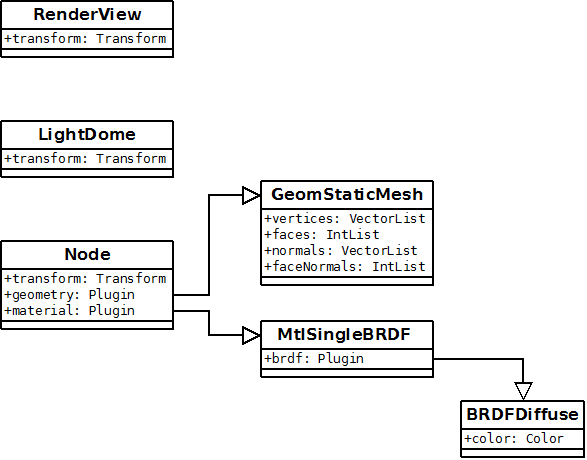Page History
...
fov- The horizontal field of view in radians.orthographic- Enable to have orthographic projection instead of perspective (RenderView::fovdoesn’t matter in this case, in favor ofRenderView::orthographicWidth).transform- A transformation (rotation + translation) which defines where the camera is and how it is rotated. The matrix is in column-major format and you will need to calculate it yourself. You can't set rotation angles as in most 3D software. The default camera orientation with identity matrix is so that +Y is pointing up and -Z is the view direction. If your scene uses +Y for up-axis, you will need to set V-Ray's scene up-axis accordingly - see the Units subsection in the settings section below.
...
Node => Instancer2 => N * Node (invisible) -> GeomSomething
and evenNode => Instancer2 => Nodes => Instancer2 => etc.
...
5. Creating materials
Exporting materials is probably the most complicated part, because it may involve complex shader networks, especially in apps with high artistic control, such as the popular DCC tools from Autodesk. Nevertheless, you can get good results even by using only a few plugins.
...
To apply a filter, just create an instance of one of those plugins. You can use only one at a time.
| Info |
|---|
| See 3dsMax docs or Maya docs for more info on filters. |
...
If you want to enable motion blur, set the SettingsMotionBlur plugin on parameter to 1. It also has the geom_samples parameter that affect quality, but may cost a lot of render time if increased. It should equal the number of geometry samples in the geometry data if it is non-static. Note that this plugin (SettingsMotionBlur) conflicts with CameraPhysical.
The SettingsLightLinker plugin allows you to define include or exclude lists for lights and objects, so that for example specific lights do not affect some objects etc. Refer to the plugin parameter metadata for explanations.
...
If you are not using CameraPhysical for depth of field, you can use SettingsCameraDof instead. Note that this plugin (SettingsCameraDof) conflicts with CameraPhysical.
on- Set to true to enable DoF.aperture- The size of the camera aperture in scene units. Note that increasing this number corresponds to decreasing the physical camera's F-number.focal_dist- Distance from the camera to the focus plane in scene units.
7. Minimal renderable scene
This is a diagram of the most simple possible scene that will render an object. These are the plugins and parameters you will need to create and set.
A. Brief plugin reference
The .vrscene can store multiple cameras, where only one can be set as ‘renderable’ at a time. The rest of the cameras can be chosen for rendering, for example in V-Ray Standalone, by using the -camera command flag. This is useful, as oftentimes a project requires rendering different sequences from different cameras, while nothing else changes in the scene - a simple example would be to render two different views of the same visualization and in this way, the same scene can be rendered twice with V-Ray Standalone. An example scene with two cameras would have one them to render by default while the other will have dont_affect_settings flag raised.
In shading setups, textures can be projected from cameras. This can either be the same camera used for rendering, or another camera in the scene, used only for projecting a texture. In both cases, an extra SettingsCamera and RenderView plugin is exported for the camera projection with the dont_affect_settings flag raised. This is similar to the Multiple Cameras setup. In all cases, it’s a good idea to export one camera for rendering, and another one for the texture projection, even if it’s the same camera, as different properties apply for each.
7. Minimal renderable scene
This is a diagram of the most simple possible scene that will render an object. These are the plugins and parameters you will need to create and set.
...
A. Brief plugin reference
This reference does not list all of V-RayThis reference does not list all of V-Ray's plugins, but most users will rarely need the ones that are not mentioned here.
...
VRayClipper
Volumetric plugins
...
The information from this page is also available at User Guide V-Ray Application SDK.

